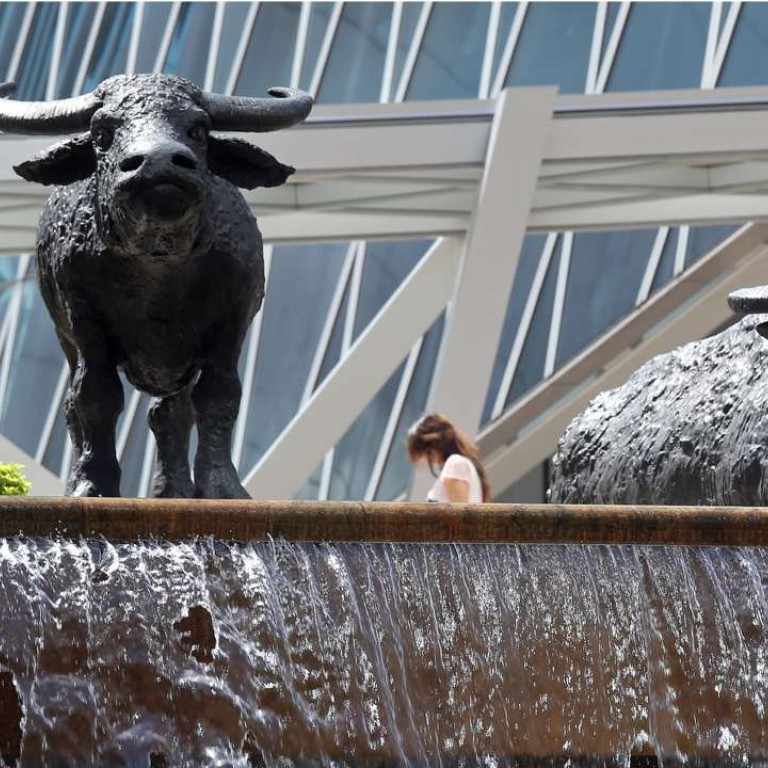
Hong Kong stocks fall to lowest level since late August on weak southbound flows and trade data
Hang Seng Index loses 1.61 per cent to end at 23,031.30
Hong Kong stocks slipped to their lowest level in a month and a half on Thursday, on the back of shrinking southbound flows via the Shanghai-Hong Kong Stock Connect link, disappointing mainland trade data, and global economic uncertainty.
The Hang Seng Index closed at 23,031.30, down 1.61 per cent or 375.75 points, its lowest point since the end of August. The Hang Seng China Enterprises Index lost 1.82 per cent to 9,673.20.
“The market overall remains very week,” Ben Kwong Man-bun, chief operating officer of KGI Asia.
“It seems investors are very cautious as the market is still undergoing a correction.”
The markets were knocked by “disappointing trade data” from China, senior market analyst at Oanda Jeffrey Halley said in a note.
China’s exports in September slumped 10 per cent year on year in US dollar terms due to weak global demand, representing the biggest drop in seven months, data from the General Administration of Customs showed.
The result was a far cry from analysts forecasts of a 3.3 per cent decline, according to a poll by Bloomberg. Imports also fell short of expectation, down 1.9 per cent in US dollar terms, missing market consensus on a 0.6 per cent rise.
“The data suggests that a drop in import volumes of a number of key commodities, including iron ore and copper....could be an early sign that the recent recovery in economic activity is losing momentum, although we would caution against reading too much into a single data point given the volatility of the trade figures,” said Julian Evans-Pritchard, China economist at Capital Economics.
Southbound capital inflows to the city through the Shanghai-Hong Kong trading link continued to be depressed, closing the day at 645.78 million yuan, down from around 900 million on Wednesday and 1.54 billion yuan on Tuesday. In September, the daily average southbound flows were between 2 to 3 billion yuan.

Other negative factors still prevail, Kwong said, such as strengthening market expectations of a US interest rate hike in December, based on the minutes of the Federal Reserve September meeting.
“They reveal that officials were fairly evenly split on the need for an interest rate rise,” Paul Ashworth, chief US economist at Capital Economics wrote in a note.
“In the increasingly likely event that Hillary Clinton is elected, we then expect the Fed to raise the fed funds rate in December.”
The probability of a rate rise by the end of this year has risen to 67 per cent from 58 per cent, Pimco global strategic advisor Rich Clarida said.
Investors are preferring “to stay on the sidelines”, according to Kwong, amid a weak pound and renminbi, as well as US and European markets that are “under a correction after the recent rally”.
Mainland stocks held their own, supported by the utilities and construction sectors, as well as a recovery for some property companies.
The Shanghai Composite Index edged up 0.09 per cent or 2.85 points to 3,061.35, and the CSI 300, which tracks companies with high capitalisation values in Shanghai and Shenzhen, gained 0.08 per cent to 3,302.65.
The Shenzhen Component Index lost 0.01 per cent to 10,787.49 while the Nasdaq-like ChiNext dropped 0.05 per cent to 2,208.57.
Blue chip losers in Hong Kong included those in the energy, gaming, and financial sectors.
Cathay Pacific Airways was the worst performer among blue chips, falling 4.65 per cent to HK$10.26 after it slashed its earnings forecast for the second half.
Major oil producers PetroChina, Sinopec and CNOOC all lost over 2 per cent, after latest data showed Opec oil output in September reached the highest level in eight years, sparking oversupply concern despite the cartel’s efforts to freeze oil production.
But the coal sector gained 0.63 per cent overall on Thursday. Yitai Coal increased 0.30 per cent to HK$6.77 and Mongolia Energy surged 7.61 per cent, although China Shenhua lost 0.65 per cent to HK$15.40.
Tencent Holdings, the most traded stock, slid 1.59 per cent to HK$210.00.
Galaxy Entertainment shares fell 2.89 per cent to HK$30.25, with Sands China decreasing 2.01 per cent to HK$34.05.
In the A-share market, the property sector recovered from losses triggered by governmental tightening measures in the housing market.
Cinda Real Estate Co shares jumped 10 per cent to the daily limit, ending at 6.22 yuan. China Vanke Co shares rose 0.79 per cent to 26.81 yuan in Shenzhen.
Elsewhere in Asian trading, Japan’s Nikkei 225 shed 0.39 per cent to 16,774.24. South Korea’s Kospi lost 0.90 per cent and in Sydney the All Ordinaries dropped 0.66 per cent.


